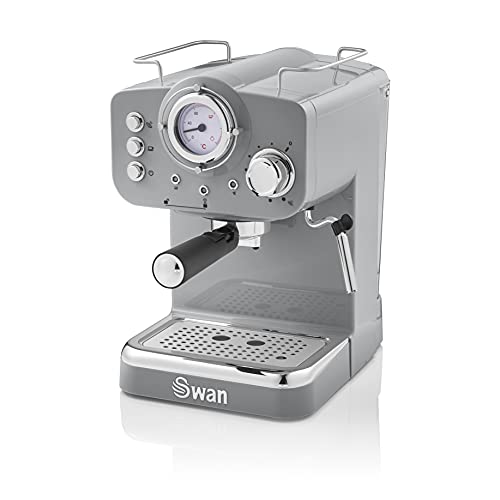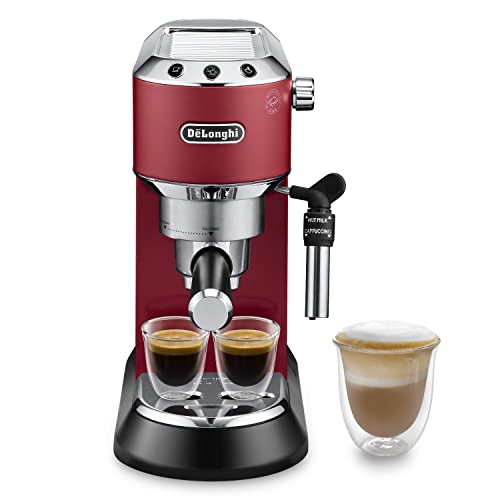不動産売買 | 11 Methods To Redesign Completely Your Machine Espresso
ページ情報
投稿人 Penelope 메일보내기 이름으로 검색 (91.♡.193.139) 作成日25-02-07 19:35 閲覧数2回 コメント0件本文
Address :
LC
How Does Machine Espresso Work?
Machine espresso makes use of precise pressure and incredible filter technology to produce the perfect cup of coffee. How exactly does it work?
 In order to make espresso hot water is pushed under pressure through finely ground coffee. The process is similar to making drip coffee but the difference is in the pressure.
In order to make espresso hot water is pushed under pressure through finely ground coffee. The process is similar to making drip coffee but the difference is in the pressure.
The Group Head
The group head is the portafilter you place in the espresso maker when making it. It disperses water into the portafilter, and controls the pressure of the extraction. There are a variety of group heads each with distinct advantages and disadvantages. Some are specifically designed for temperature stability while others are designed to handle pre-infusion. Some are designed to control the lever. Some have a combination, like the E61. This is a favorite among baristas since it provides multiple benefits in a single package.
As you can see in the image above the group head is equipped with several notches. The portafilter is placed in these notches, then twist the head to lock it. A gasket of rubber is situated inside the notches to help create a seal while you insert your portafilter. The notches permit an exact placement of the portafilter. This is crucial to ensure an accurate extraction.
The group head does not just allow you to put in your portafilter easily however, it also keeps the same temperature. It does this by circulating hot water through the brew basket and around the portafilter, ensuring that it is always at the right temperature to extract. This is crucial, since just a few degrees could make the difference between a good and great espresso.
The Pump
Contrary to manual piston machines which use a lever to pressurize water, rotating espresso machines rely upon motorized pumps to provide the nine atmospheric bars of pressure necessary for espresso extraction. The pressure builds by removing tap water from a reservoir and espresso maker pumping it through a heat exchanger prior to being shot through the ground coffee inside the group head.
Pumps are generally less expensive and last for longer than piston-driven machines. However, both types of machines may degrade because of excessive use and inadequate cleaning. They also create mechanical complexity and can lead to an expensive price for even the most basic models.
Some espresso machines use steam pressure instead of a pump to make espresso. This could lead to over-extraction since the boiler that produces steam also heats the water until it comes to a boil. In addition the machines often have to rebuild their pressure between cups, which requires time and energy.
A majority of best home espresso machine machines utilize either a vibration or rotary pump. A vibration model uses a vibrating disk to generate pressure, whereas a rotating model pushes hot water through the ground at a fast speed. Both types of machine can produce an excellent espresso, but Rotary machines are quieter and more durable than vibration pumps.
The Boiler
The boiler is used to heat the water to the perfect temperature to extract. The steam that is created will eventually reach the portafilter, which is the container that holds the espresso coffee grounds. The steam is then channeled into the cup. In this process, the steam creates pressure to push through the coffee grounds. This produces a layer of crema on top. This is one of the main characteristics of a great espresso.
There are three types of espresso makers, which differ in the type of pump they employ and how hot the espresso is. There are also different ways that the brew can be controlled, as well as the size of the cup the machine can produce.
The first espresso machines were steam-type. The earliest espresso machines were steam-type machines. This resulted in the coffee tasting burnt and bitter. The modern espresso machine was created by the Milanese makers Luigi Bezzerra & Desiderio Pavoni.
The most popular espresso maker is a semiautomatic machine with an electric pump. These are the images people have when they think of an espresso maker. Semi-automatic machines require you to grind and tamp the beans by yourself however the pump controls the flow of water and pressure. This is an excellent compromise between human touch and the mechanised quality.
The Filter
espresso machine black friday machines typically have a filter that separates the grounds of the coffee from hot water. The filter is also an essential component of the machine's temperature control, since it stops overheating.
Filters also aid in flavor, as it permits a longer flowering phase. This lets the beans release their nuances, and also allows for better extraction.
However, it is important to remember that even a great filter can result in a poor cup of coffee, espresso maker because the quality of the beans and extraction is crucial.
It's in this area that the magic happens. This is what makes espresso taste so good. The grouphead (also known as the brewhead) is where you put the portafilter, the thingy that you put the coffee grounds in, when making espresso.
In an espresso machine that is driven by steam, hot water is heated in an airtight tank to create steam, which is then pushed through the grounds at a high pressure. These kinds of machines are typically cheaper and easier to maintain than pump-driven models. However, they are limited in their ability to produce the perfect conditions for brewing, since they operate at 1-1.5 bars of pressure. The perfect shot requires 9-10 bars.
In recent years, compressed air pump-driven best budget espresso machine machines have become more popular. They use an air compressor to push hot water across the ground, and are more mobile than electric steam-driven espresso maker barista machines.
Machine espresso makes use of precise pressure and incredible filter technology to produce the perfect cup of coffee. How exactly does it work?
 In order to make espresso hot water is pushed under pressure through finely ground coffee. The process is similar to making drip coffee but the difference is in the pressure.
In order to make espresso hot water is pushed under pressure through finely ground coffee. The process is similar to making drip coffee but the difference is in the pressure.The Group Head
The group head is the portafilter you place in the espresso maker when making it. It disperses water into the portafilter, and controls the pressure of the extraction. There are a variety of group heads each with distinct advantages and disadvantages. Some are specifically designed for temperature stability while others are designed to handle pre-infusion. Some are designed to control the lever. Some have a combination, like the E61. This is a favorite among baristas since it provides multiple benefits in a single package.
As you can see in the image above the group head is equipped with several notches. The portafilter is placed in these notches, then twist the head to lock it. A gasket of rubber is situated inside the notches to help create a seal while you insert your portafilter. The notches permit an exact placement of the portafilter. This is crucial to ensure an accurate extraction.
The group head does not just allow you to put in your portafilter easily however, it also keeps the same temperature. It does this by circulating hot water through the brew basket and around the portafilter, ensuring that it is always at the right temperature to extract. This is crucial, since just a few degrees could make the difference between a good and great espresso.
The Pump
Contrary to manual piston machines which use a lever to pressurize water, rotating espresso machines rely upon motorized pumps to provide the nine atmospheric bars of pressure necessary for espresso extraction. The pressure builds by removing tap water from a reservoir and espresso maker pumping it through a heat exchanger prior to being shot through the ground coffee inside the group head.
Pumps are generally less expensive and last for longer than piston-driven machines. However, both types of machines may degrade because of excessive use and inadequate cleaning. They also create mechanical complexity and can lead to an expensive price for even the most basic models.
Some espresso machines use steam pressure instead of a pump to make espresso. This could lead to over-extraction since the boiler that produces steam also heats the water until it comes to a boil. In addition the machines often have to rebuild their pressure between cups, which requires time and energy.
A majority of best home espresso machine machines utilize either a vibration or rotary pump. A vibration model uses a vibrating disk to generate pressure, whereas a rotating model pushes hot water through the ground at a fast speed. Both types of machine can produce an excellent espresso, but Rotary machines are quieter and more durable than vibration pumps.
The Boiler
The boiler is used to heat the water to the perfect temperature to extract. The steam that is created will eventually reach the portafilter, which is the container that holds the espresso coffee grounds. The steam is then channeled into the cup. In this process, the steam creates pressure to push through the coffee grounds. This produces a layer of crema on top. This is one of the main characteristics of a great espresso.
There are three types of espresso makers, which differ in the type of pump they employ and how hot the espresso is. There are also different ways that the brew can be controlled, as well as the size of the cup the machine can produce.
The first espresso machines were steam-type. The earliest espresso machines were steam-type machines. This resulted in the coffee tasting burnt and bitter. The modern espresso machine was created by the Milanese makers Luigi Bezzerra & Desiderio Pavoni.
The most popular espresso maker is a semiautomatic machine with an electric pump. These are the images people have when they think of an espresso maker. Semi-automatic machines require you to grind and tamp the beans by yourself however the pump controls the flow of water and pressure. This is an excellent compromise between human touch and the mechanised quality.
The Filter
espresso machine black friday machines typically have a filter that separates the grounds of the coffee from hot water. The filter is also an essential component of the machine's temperature control, since it stops overheating.
Filters also aid in flavor, as it permits a longer flowering phase. This lets the beans release their nuances, and also allows for better extraction.
However, it is important to remember that even a great filter can result in a poor cup of coffee, espresso maker because the quality of the beans and extraction is crucial.
It's in this area that the magic happens. This is what makes espresso taste so good. The grouphead (also known as the brewhead) is where you put the portafilter, the thingy that you put the coffee grounds in, when making espresso.
In an espresso machine that is driven by steam, hot water is heated in an airtight tank to create steam, which is then pushed through the grounds at a high pressure. These kinds of machines are typically cheaper and easier to maintain than pump-driven models. However, they are limited in their ability to produce the perfect conditions for brewing, since they operate at 1-1.5 bars of pressure. The perfect shot requires 9-10 bars.
In recent years, compressed air pump-driven best budget espresso machine machines have become more popular. They use an air compressor to push hot water across the ground, and are more mobile than electric steam-driven espresso maker barista machines.

【コメント一覧】
コメントがありません.

